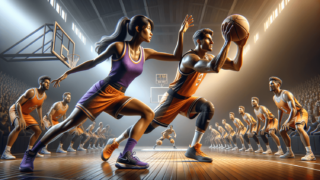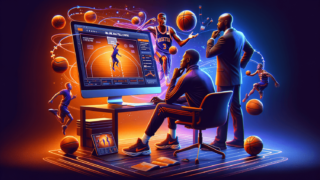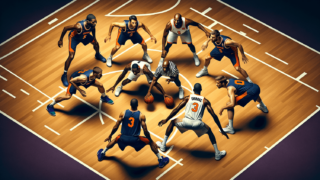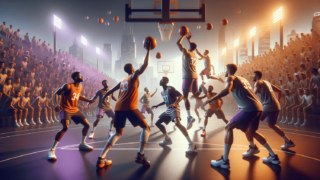
How to Increase Your Basketball Speed and Agility Training?
Written by: Basketball Universe
Last updated:

If you’re looking to gain a competitive edge on the basketball court, then you’ve come to the right place! In our latest blog post, “How to Increase Your Basketball Speed and Agility Training?”, we’ll be diving into the essential techniques and drills that can help you elevate your game to new heights. With a focus on speed, agility, and quickness, this post will be a treasure trove of valuable information for any aspiring baller looking to leave their opponents in the dust. So, lace up your sneakers and get ready to hustle, because we’re about to take your basketball skills to the next level!
How to Increase Your Basketball Speed and Agility Training?
To increase your basketball speed and agility training, it’s essential to focus on a combination of strength training, plyometrics, and sport-specific drills. Begin with exercises that target your lower body and core, such as squats, lunges, and planks, to provide a strong foundation. Plyometric exercises, like box jumps and lateral bounds, can help develop explosive power for quicker movements. Incorporate sport-specific drills that focus on acceleration, deceleration, and change of direction to mimic game scenarios. Consistency and intensity in your training, alongside appropriate rest and recovery, will maximize your potential for increased speed and agility on the court.
Building a Strong Foundation: Strength Training and Core Work
Before you can truly increase your basketball speed and agility, you’ll need to ensure that your body is equipped to handle the physical demands of the sport. Strength training with a focus on the lower body and core muscles is crucial in developing a strong foundation to support swift and agile movements on the court.
Lower Body Exercises
Include a range of leg-focused exercises to target the quadriceps, hamstrings, glutes, and calves. These muscle groups drive your speed and agility, so be sure to incorporate exercises like:
- Squats: Stand with your feet shoulder-width apart, chest forward, and back straight. Lower yourself down as if sitting into a chair, then push back up through your heels to return to the standing position.
- Deadlifts: Stand with feet hip-width apart and a barbell at your shins. Bend at your hips and knees, grip the barbell, and lift it by straightening your legs and engaging your glutes as you rise to a standing position. Lower the barbell back to the ground with control.
- Lunges: With your feet shoulder-width apart and your hands on your hips, take a step forward with your right foot. Lower your body down until your right knee is at a 90-degree angle. Push back up and return to the starting position. Repeat with the left foot.
Core Workouts
Don’t forget to target the core muscles, which play a significant role in stabilization, balance, and coordination on the basketball court. Incorporate exercises like:
- Planks: Rest your forearms and toes on the ground, maintaining a straight line from head to heel. Engage your core and hold this position for as long as possible before lowering down to rest.
- Russian Twists: Sit on the ground with your knees bent and feet flat, then lean back slightly. Hold a weight or medicine ball in your hands and twist your torso to move the weight from one hip to the other, engaging the obliques in the process.
- Leg Raises: Lie on your back with your legs extended and hands by your sides. Engage your core to lift your legs off the ground until they are perpendicular to the floor. Lower them back down with control.
Explosive Power: Plyometrics for Basketball Speed and Agility
Plyometric exercises focus on increasing your muscle power, allowing for rapid bursts of speed and improved agility. The following plyometric movements will enhance your on-court performance:
Box Jumps
Stand in front of a sturdy box or platform. With your feet shoulder-width apart, lower into a half-squat and explode upward, jumping onto the box with both feet. Step or jump back down and repeat for a given number of reps.
Lateral Bounds
Begin with your feet shoulder-width apart and your knees slightly bent. Push off your right foot and jump sideways to your left, landing on your left foot. Then, push off your left foot and jump back to the right, landing on your right foot. Continue alternating sides, focusing on maintaining good balance and control.
Depth Jumps
Stand on an elevated surface, like a box or bench, with your feet hip-width apart. Step off the surface, landing on both feet with slightly bent knees. Immediately jump upward, reaching as high as possible. Land softly with bent knees, then reset and repeat.
Training for the Game: Sport-Specific Drills
To make the most of your speed and agility training, incorporate sport-specific drills into your workouts. These drills simulate game-like situations, helping you improve your performance on the court.
Acceleration and Deceleration Drills
Being able to accelerate and decelerate quickly is crucial in basketball. Practice these movements with drills like:
- Shuttle Runs: Set up two cones or markers about 25 feet apart. Starting at one cone, sprint to the other cone, touching it with your hand. Reverse direction and sprint back. Repeat for a given number of reps, focusing on quick stops and starts.
- Line Drills: In a gym or on a basketball court, sprint from one baseline to the free throw line, then quickly change direction and sprint back to the baseline. Continue to the half court line, the opposite free throw line, and finally the opposite baseline, focusing on rapid acceleration and deceleration at each turn.
Change-of-Direction Drills
Agility on the basketball court often involves quickly changing direction while maintaining balance and control. Improve this skill with drills like:
- Zigzag Runs: Set up a series of cones in a zigzag pattern. Starting at the first cone, sprint to each subsequent cone, rounding it with tight turns. Focus on maintaining speed while changing direction throughout the course.
- Defensive Slides: Assume a defensive stance with your feet shoulder-width apart and knees slightly bent. Slide laterally in one direction, then switch direction and slide back. Repeat for a given number of reps or time, ensuring that your feet never cross and your knees stay bent to maintain a low stance.
Finding Balance: Rest and Recovery
As important as it is to work hard in your speed and agility training, it’s equally crucial to give your body time to recover. Overtraining can lead to injury and diminished performance, so make sure to incorporate rest days and active recovery activities like stretching, yoga, and light cardio to keep your body in peak condition for basketball success.
Optimizing Nutrition for Performance and Recovery
Alongside your training program, the food you fuel your body with plays a critical role in supporting your basketball speed and agility development. Proper nutrition can enhance energy levels, support muscle growth, and aid in recovery. Take the following tips into consideration when optimizing your athlete diet:
Balance Your Macronutrients
As a basketball player, your diet should be well-rounded, incorporating a balance of carbohydrates, proteins, and healthy fats. Carbohydrates provide the energy necessary for high-intensity workouts and games, proteins support muscle growth and repair, and healthy fats serve as an energy reserve and support overall health.
Timing is Key
When you eat can be as crucial as what you eat when it comes to performance and recovery. Aim to eat a balanced meal about 2-3 hours before a workout or game. Post-workout, consume a meal or snack containing both carbohydrates and proteins within 1-2 hours to kickstart the recovery process efficiently.
Stay Hydrated
Maintaining proper hydration is essential for athletic performance, especially in an intense sport like basketball. Drink water consistently throughout the day and pay particular attention to replenish fluids before, during, and after workouts or games. Adequate hydration supports muscle function and can aid in reducing fatigue and injury risk.
Mastering Your Mental Game
A vital yet often overlooked aspect of improving speed and agility in basketball is mental resilience. Developing mental toughness and incorporating visualization techniques can help support your physical training and overall performance on the court.
Build Confidence Through Positive Thinking
Belief in your abilities and the confidence to perform at your best are powerful tools that elite athletes use to their advantage. Encourage yourself with positive self-talk and affirmations, which can reinforce self-belief and minimize performance-related anxiety.
Utilize Visualization Techniques
Visualizing yourself executing basketball situations and maneuvers with speed and agility can help support your physical training. The mental imagery of success on the court can translate into actual performance gains, as your brain develops neural pathways related to the skills being visualized.
Track and Measure Your Progress
Recording and analyzing your progress is vital for staying motivated and identifying areas of improvement. Keep a training journal noting the details of your workouts, along with regular assessments of your speed, agility, and overall performance. Monitoring your progress will help you refine your training program and ensure you are continually pushing towards your goals.
FAQ Section: Speed and Agility Training for Basketball
Get your burning questions answered about enhancing your speed and agility for basketball with our comprehensive FAQ section. Learn more about the training methods, best practices, and benefits you can expect.
1. How often should I train to improve my basketball speed and agility?
For optimal results, aim for 2-3 speed and agility training sessions per week, coupled with regular strength training, conditioning, and skill development. Remember to listen to your body and prioritize rest and recovery to avoid overtraining.
2. How long does it take to see improvements in speed and agility?
Results may vary depending on your current fitness level, experience, and commitment to training. Generally, expect to see noticeable improvements in your speed and agility within 4 to 6 weeks of consistent, focused training.
3. Can I perform speed and agility training without access to a gym or basketball court?
Yes, many speed and agility exercises can be performed outside a traditional gym or court setting. Use open spaces like parks, playgrounds, or even your backyard for shuttle runs, lateral bounds, and other agility-focused movements.
4. What type of footwear should I wear for speed and agility training?
Choose supportive, well-fitting athletic shoes with good traction and stability. Basketball shoes or cross-trainers can be an excellent choice, providing the necessary ankle support and cushioning for your training.
5. How important is core strength for basketball speed and agility?
Core strength is crucial for basketball speed and agility since it stabilizes your body and aids in balance, coordination, and explosive movements. Developing a strong core can help you control your movements and maintain body position during rapid changes in direction.
6. What role does flexibility play in speed and agility?
Flexibility and mobility are essential for optimally performing speed and agility exercises. Improved flexibility enables greater freedom of movement, reduces injury risk, and ensures that your muscles can generate force more efficiently.
7. How can interval training support my speed and agility development?
Interval training, consisting of alternating periods of high-intensity work with lower-intensity recovery periods, can help increase your explosive power and endurance. This training method can simulate the constantly changing pace of a basketball game, ultimately benefiting your speed and agility.
8. When should I progress to more advanced speed and agility exercises?
Progress to more advanced exercises when you feel confident in your current movements and have developed a strong foundation of strength, flexibility, and balance. Gradual progression ensures that your body can adapt to increased challenges and demands safely and effectively.
9. Can strength training slow me down on the basketball court?
Strength training, when performed in combination with speed and agility exercises, should not slow you down. In fact, it can enhance your power and help you generate speed more effectively. Ensure that your training program includes plyometrics and sport-specific drills to maintain and improve your speed.
10. Can older players still improve their speed and agility?
Yes, older players can continue to improve their speed and agility with proper training and consistency. While age may play a role in overall athletic potential, focusing on maintaining strength, flexibility, and mobility can help preserve and even enhance speed and agility performance.
Featured Posts
- No pillar pages found.





